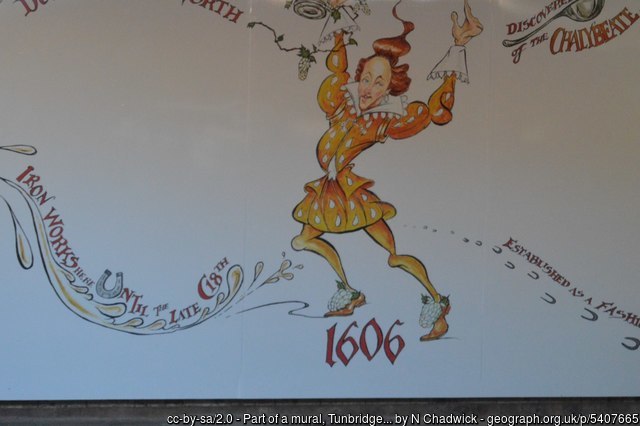As part of our focus on health and medicine, Dr Ben Coates of the Lords 1604-29 Section considers the origins of the famous spa at Tunbridge Wells, Kent, and ponders whether the parliamentary context might shed light on the date of these events…
In March 2017 a new, cartoon-style mural by artist Chris Burke was unveiled on platform 2 of Tunbridge Wells station in Kent. This replaced an older mural painted in 1989 by Brian Barnes, which had been removed for safety reasons. Like its predecessor, the new artwork illustrates the history of the town and, also like its predecessor, it depicts Dudley North, 3rd Lord North who, we are informed, ‘discovered the healing properties of the chalybeate spring’ in 1606.

According to an eighteenth-century historian of the town, North had fallen ‘into a lingering consumptive disorder’ which defied the ministrations of his doctors. Seeking a cure, in the spring of 1606 he retired to Eridge House, a hunting lodge about two-and-a-half miles from Tunbridge Wells, belonging to his friend Edward Neville, 8th or 1st Lord Abergavenny. He stayed there about six weeks but, finding no improvement in his condition, set out to return to London. Passing through a wood, he came across a spring and noticed that the water had a ‘shining mineral scum’ and a ‘ferruginous’ [i.e. rusty] taste, causing him to suspect that it might have medicinal properties. He had some bottled and brought back with him to London, where his physicians confirmed its beneficial properties. He subsequently returned to Eridge and, after three months, the combination of the spring water and pure country air had wrought a total cure.
There are good reasons for accepting this account. North himself wrote that he ‘first made known to London and the king’s people’ the ‘uses of Tunbridge and Epsom waters for health and cure’. Moreover, although North lived to be over 80, his writings are full of complaints about his health, which he believed had been permanently impaired by the overuse of a ‘treacle’ he had taken to guard against the bubonic plague during the 1603 epidemic, one of the worst of the seventeenth century. (This treacle was probably theriac, otherwise known as Venice treacle, a preparation which typically included viper’s flesh and opium).
However, there is a problem with dating his discovery to the spring of 1606. Parliament was in session from 21 January until 27 May and, although North was only recorded as attending slightly more than half the sittings of the House of Lords during this time, there is no period of absence long enough to accommodate a six week stay at Eridge. It is, of course, possible that the incident took place later that year. However, there is an alternative account, recorded by a descendant of Lord Abergavenny’s steward. In this version, dated to 1615 or 1616, North discovered the spring while journeying to Eridge, and thought that the waters must have medicinal properties because they tasted like those of Spa, in modern Belgium, whose waters were so famous that the town became synonymous with medicinal watering-places. Whatever the date of North’s discovery, in 1619 it was reported that for three or four years the waters of Tunbridge ‘have been much frequented’ and the fortunes of a spa town had been made.
BC
For further details see:
- B. Burr, History of Tunbridge-Wells (1766), 5-14
- [D. North], Forest of Varieties (1645), 122, 134, 214
- ‘Papers Relating to Proceedings in the County of Kent’ ed. R. Almack in Camden Miscellany iii (Camden Society lxi, 1854), p. v
- Chamberlain Letters N.E. McClure (1939), ii. 261
Biographies of Lords North and Abergavenny will appear in the History of Parliament’s volumes on The House of Lords 1604-29, scheduled for publication in 2019.

Dudley North, 3rd Lord North, played a significant role in the history of Tunbridge Wells through his discovery of the town’s famous mineral waters. His exploration and recognition of the healing properties of the Chalybeate Spring led to the establishment of Tunbridge Wells as a renowned spa destination. Lord North’s role in uncovering the waters of Tunbridge Wells is a testament to the power of exploration and the enduring appeal of natural remedies.